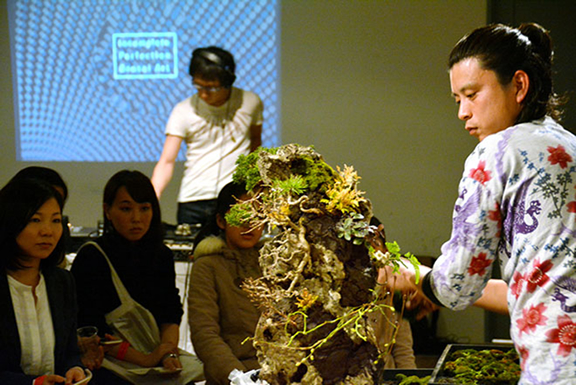THE ASAHI SHIMBUN
May 4, 2016 at 11:15 JST
Masashi Hirao, right, a bonsai artist, performs his show to music played by a disc jockey, background, in Tokyo’s Meguro Ward in February. (Kai Uchida)
With the World Bonsai Convention set to come home to Japan in 2017 for the first time in 28 years, the traditional art form is perfectly positioned for a re-evaluation.
While many Japanese people see growing miniature potted plants as a hobby for elderly men, it’s a different story overseas, where all ages enjoy bonsai in ways specific to each place.
Industry figures in Japan have high expectations for the eighth world convention, to be held in Saitama from April 27-30, 2017.
“Bonsai is a nonverbal art, like music,” said Edoardo Rossi, a bonsai artist from Italy, at the International Bonsai Symposium held this February in Tokyo. “It is a universal language.”
Rossi, who participated as a panelist in the run-up event of the quadrennial convention, has been engaged in bonsai cultivation for 30 years.
The 55-year-old studied at a bonsai school opened by a Japanese in Italy for eight years, and is now teaching 150 students in their teens to their 80s the skills and techniques to grow artistic trees and shrubs.
Rossi said he and his students often use rosemary, olive trees and other plants grown in the Mediterranean region to create their works.
“My focus is on improving my inner self through the process of growing bonsai,” said Rossi.
In the United States and Europe, many young people take care of their own bonsai pieces. Unlike in Japan, those young artists take full advantage of Internet services, such as taking online courses to study how to prune and raise trees, as well as interacting with each other on Facebook.
The culture of bonsai cultivation is said to have spread outside Japan after bonsai works went on display during the 1964 Tokyo Olympics and the 1970 Osaka Expo.
Artists from the Omiya Bonsai Village in Saitama, which bonsai nurseries formed about 90 years ago, devoted themselves to introducing the Japanese traditional art to other parts of the world.
They welcomed many followers and visitors from overseas, and also traveled outside Japan to offer lessons and training.
Saburo Kato, who died at age 92 in 2008, was the leading light in the efforts to spread bonsai abroad.
His motto of “peace-oriented diplomacy based on bonsai” was embodied by the first World Bonsai Convention, which was held in Omiya (present-day Saitama) in 1989 and drew more than 700 people from 30 countries across the globe.
Through demonstrations and workshops, visitors to the convention forged deep connections, as Kato had hoped.
Kato had also been looking to establish a center to exhibit bonsai works alongside related documents and materials. His dream eventually came true in 2010, when the Omiya Bonsai Art Museum was opened in Saitama.
While only 1,225 people from overseas visited the museum in 2011, the number sharply rose to 4,165 by 2015.
Masashi Hirao, 35, came to the Omiya Bonsai Village in 2003 after being impressed by the beauty of Japanese-style gardens during his school days. Hirao said he is Kato’s “last disciple.”
According to Hirao, his master, then aged 88, frequently said that bonsai art “has to expand to overseas.”
Taking his cue from Kato, Hirao has toured more than 30 countries to provide lessons and demonstrations, and finally came up with the idea of performing with disc jockeys and live music at bars and nightclubs.
His “bonsai performance” combines the art form with music and alcohol, and has attracted interest from many foreigners who have never viewed bonsai before.
In February this year in Tokyo’s Meguro Ward, Hirao performed his first bonsai show in Japan.
About 80 people–many of them in their 20s and 30s–visited the venue to see Hirao’s performance in which he rhythmically planted trees in hollows in a stone, using soil for horticulture and wires, to music played by a disc jockey.
“Even people who had not shown an interest in bonsai enjoyed my show,” said Hirao. “I will make efforts to make the upcoming convention a place where people from Japan and overseas can form bonds with one another and enjoy the experience together.”
The world convention has been held in the United States, Germany and elsewhere, and will eventually return to Saitama.
Kato’s eldest son, Hatsuji, 73, who heads the eighth convention’s executive committee, said he hopes the upcoming event will help boost the popularity of bonsai among the Japanese.
“I hope young people in Japan will change their attitudes to bonsai through exchanges with people from around the world,” he said. “I’m pinning my hopes on this opportunity.”
(This article was written by Aiko Masuda and Kai Uchida.)
The Asahi Shimbun
http://www.asahi.com/ajw/articles/AJ201605040009.html

